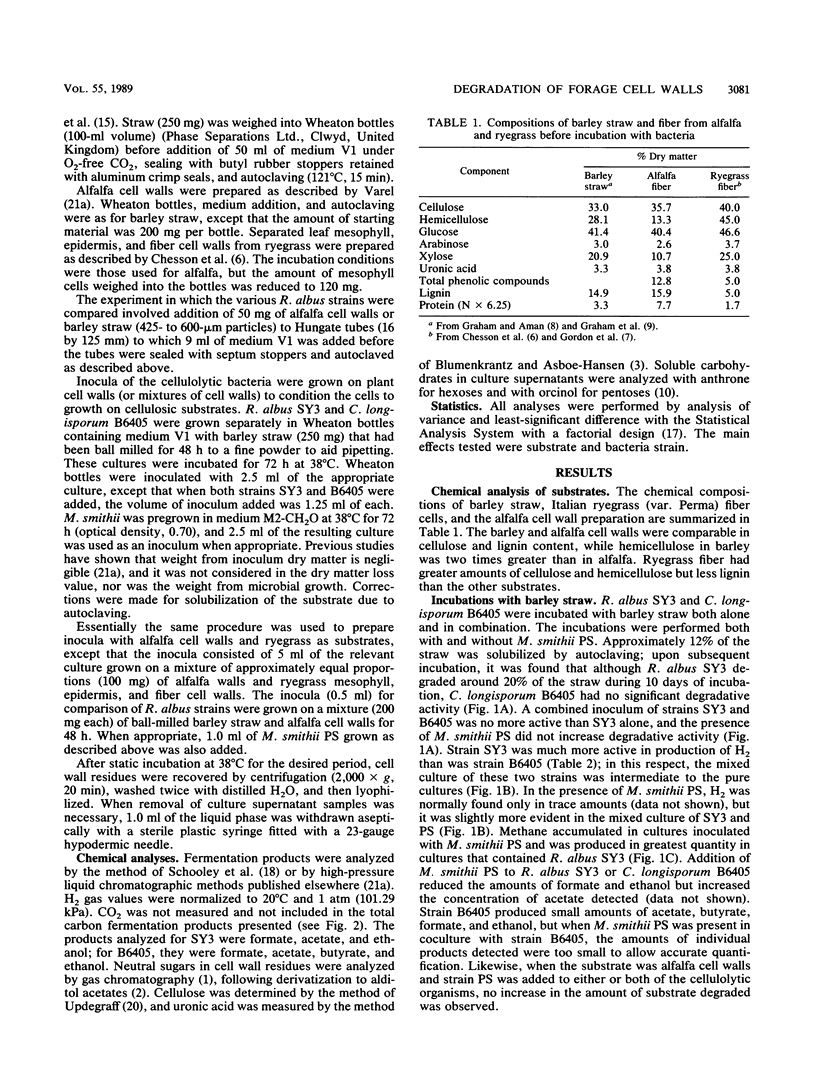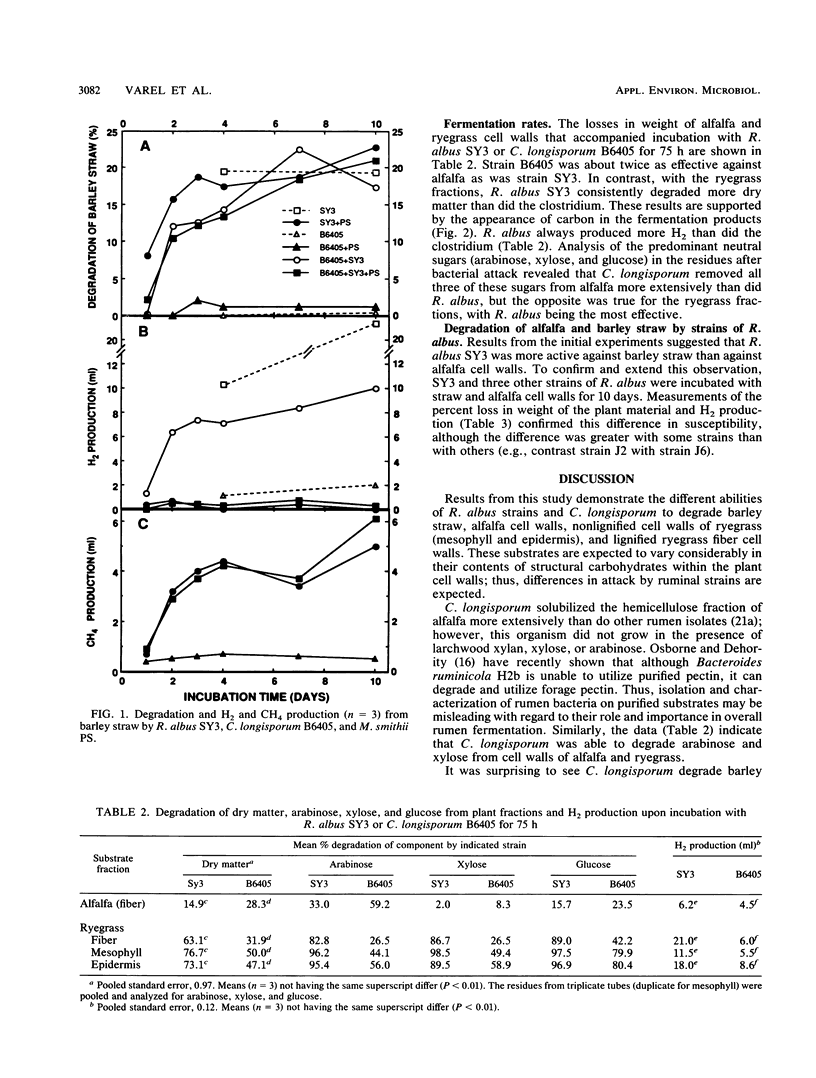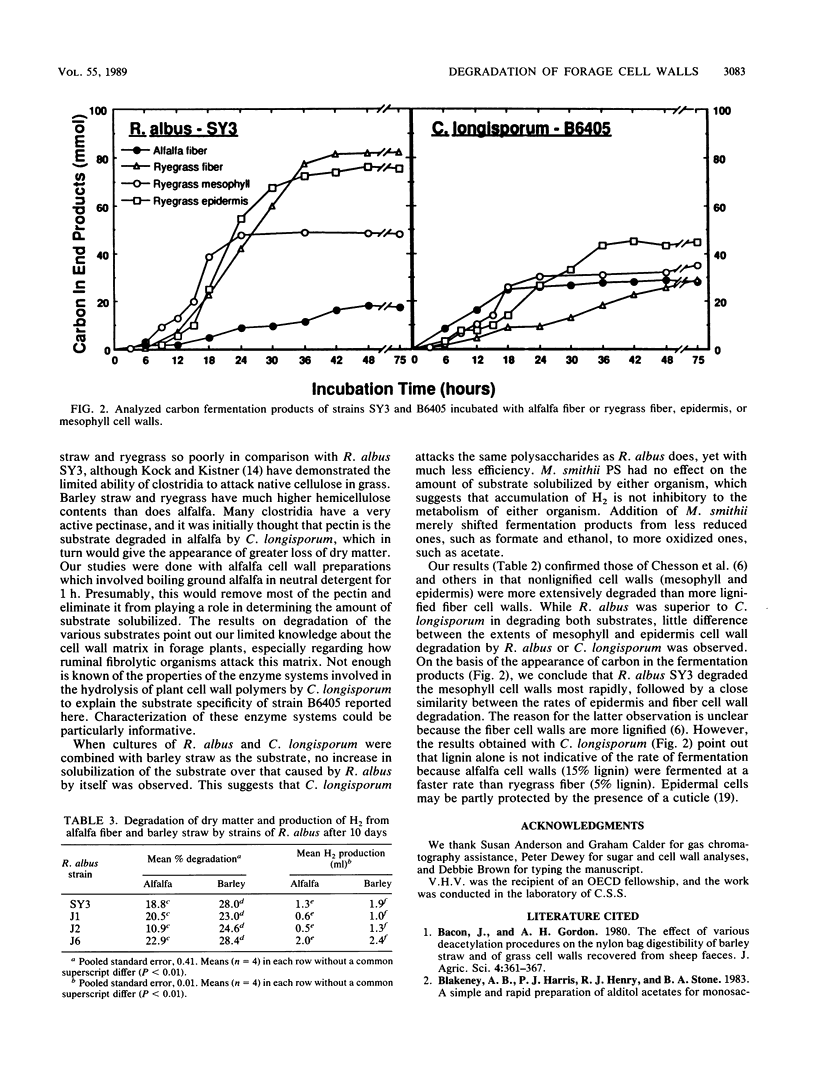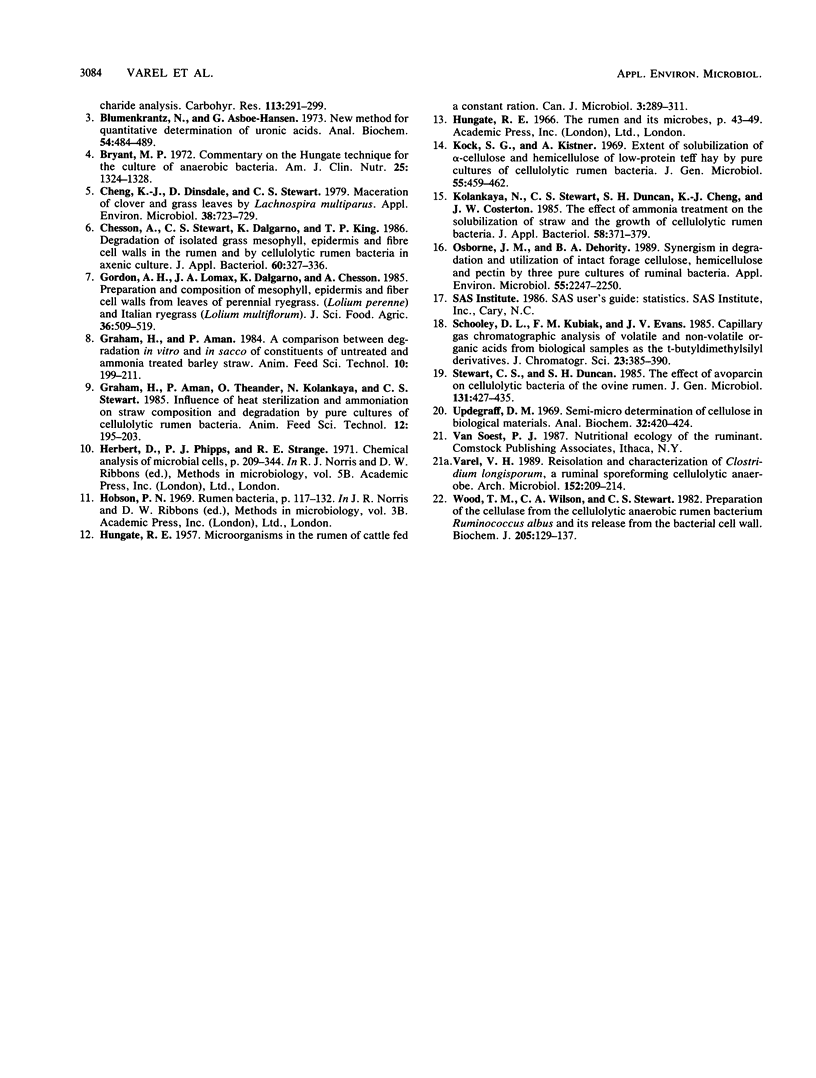Abstract
The recently isolated ruminal sporeforming cellulolytic anaerobe Clostridium longisporum B6405 was examined for its ability to degrade barley straw, nonlignified cell walls (mesophyll and epidermis) and lignified cell walls (fiber) of ryegrass, and alfalfa cell walls in comparison with strains of Ruminococcus albus. R. albus strains degraded 20 to 28% of the dry matter in barley straw in 10 days, while the clostridium degraded less than 2%. A combined inoculum of R. albus SY3 and strain B6405 was no more efficient than SY3 alone, and the presence of Methanobacterium smithii PS did not increase the amount of dry matter degraded. In contrast, with alfalfa cell walls as the substrate, the clostridium was twice as active (28% weight loss) as R. albus SY3 (15%). The percentages of dry matter degraded from ryegrass cell walls of mesophyll, epidermis, and fiber for the clostridium were 50, 47, and 32%, respectively, and for R. albus SY3 they were 77, 73, and 63%, respectively. Analyses of the predominant neutral sugars (arabinose, xylose, and glucose) in the plant residues after bacterial attack were consistent with the values for dry matter weight loss. Measurements of the amount of carbon appearing in the fermentation products indicated that R. albus SY3 degraded ryegrass mesophyll cell walls most rapidly, with epidermis and fiber cell walls being degraded at similar rates. Strain B6405 attacked alfalfa cell walls at a rate greater than that of any of the ryegrass substrates. These results indicate an unexpected degree of substrate specificity in the ability of C. longisporum to degrade plant cell wall material.
Full text
PDF




Selected References
These references are in PubMed. This may not be the complete list of references from this article.
- Blumenkrantz N., Asboe-Hansen G. New method for quantitative determination of uronic acids. Anal Biochem. 1973 Aug;54(2):484–489. doi: 10.1016/0003-2697(73)90377-1. [DOI] [PubMed] [Google Scholar]
- Bryant M. P. Commentary on the Hungate technique for culture of anaerobic bacteria. Am J Clin Nutr. 1972 Dec;25(12):1324–1328. doi: 10.1093/ajcn/25.12.1324. [DOI] [PubMed] [Google Scholar]
- Cheng K. J., Dinsdale D., Stewart C. S. Maceration of Clover and Grass Leaves by Lachnospira multiparus. Appl Environ Microbiol. 1979 Oct;38(4):723–729. doi: 10.1128/aem.38.4.723-729.1979. [DOI] [PMC free article] [PubMed] [Google Scholar]
- HUNGATE R. E. Microorganisms in the rumen of cattle fed a constant ration. Can J Microbiol. 1957 Mar;3(2):289–311. doi: 10.1139/m57-034. [DOI] [PubMed] [Google Scholar]
- Kock S. G., Kistner A. Extent of solubilization of alpha-cellulose and hemicellulose of low-protein teff hay by pure cultures of cellulolytic rumen bacteria. J Gen Microbiol. 1969 Mar;55(3):459–462. doi: 10.1099/00221287-55-3-459. [DOI] [PubMed] [Google Scholar]
- Kolankaya N., Stewart C. S., Duncan S. H., Cheng K. J., Costerton J. W. The effect of ammonia treatment on the solubilization of straw and the growth of cellulolytic rumen bacteria. J Appl Bacteriol. 1985 Apr;58(4):371–379. doi: 10.1111/j.1365-2672.1985.tb01476.x. [DOI] [PubMed] [Google Scholar]
- Osborne J. M., Dehority B. A. Synergism in degradation and utilization of intact forage cellulose, hemicellulose, and pectin by three pure cultures of ruminal bacteria. Appl Environ Microbiol. 1989 Sep;55(9):2247–2250. doi: 10.1128/aem.55.9.2247-2250.1989. [DOI] [PMC free article] [PubMed] [Google Scholar]
- Schooley D. L., Kubiak F. M., Evans J. V. Capillary gas chromatographic analysis of volatile and non-volatile organic acids from biological samples as the t-butyldimethylsilyl derivatives. J Chromatogr Sci. 1985 Sep;23(9):385–390. doi: 10.1093/chromsci/23.9.385. [DOI] [PubMed] [Google Scholar]
- Updegraff D. M. Semimicro determination of cellulose in biological materials. Anal Biochem. 1969 Dec;32(3):420–424. doi: 10.1016/s0003-2697(69)80009-6. [DOI] [PubMed] [Google Scholar]
- Varel V. H. Reisolation and characterization of Clostridium longisporum, a ruminal sporeforming cellulolytic anaerobe. Arch Microbiol. 1989;152(3):209–214. doi: 10.1007/BF00409652. [DOI] [PubMed] [Google Scholar]
- Wood T. M., Wilson C. A., Stewart C. S. Preparation of the cellulase from the cellulolytic anaerobic rumen bacterium Ruminococcus albus and its release from the bacterial cell wall. Biochem J. 1982 Jul 1;205(1):129–137. doi: 10.1042/bj2050129. [DOI] [PMC free article] [PubMed] [Google Scholar]


